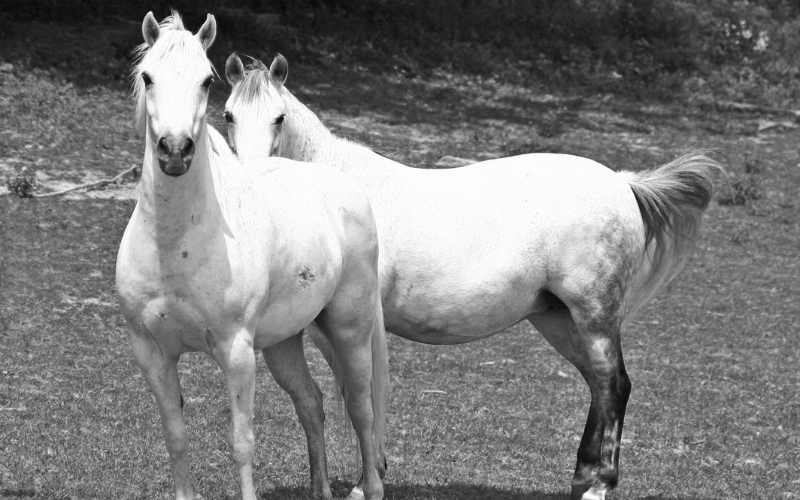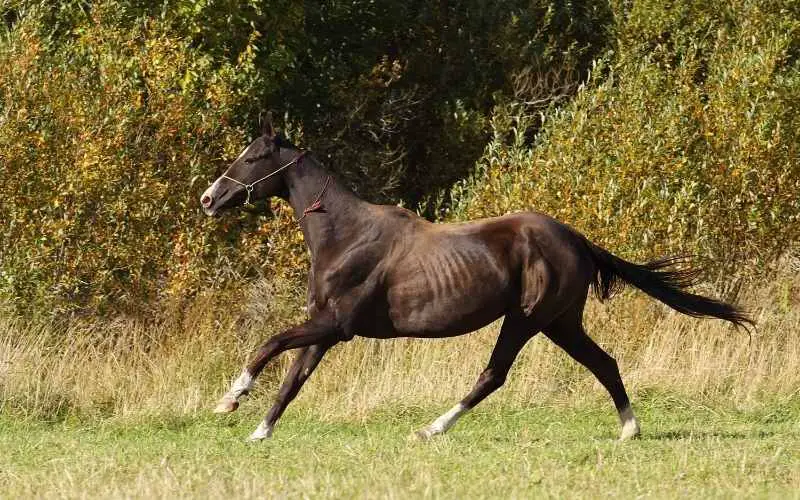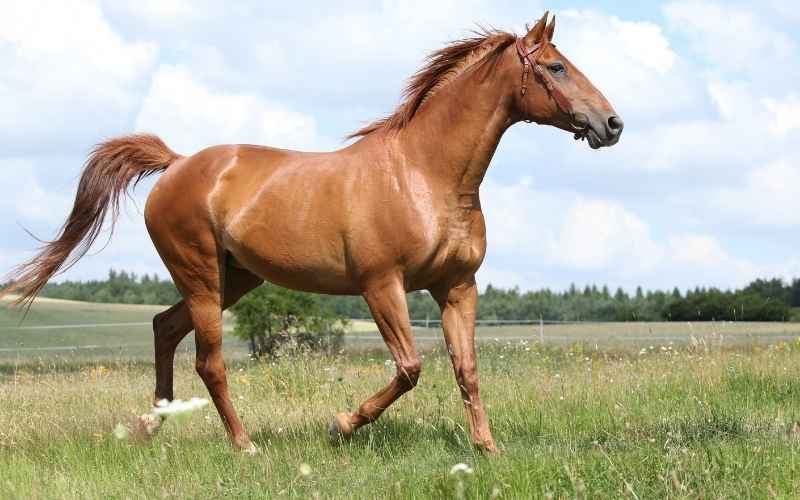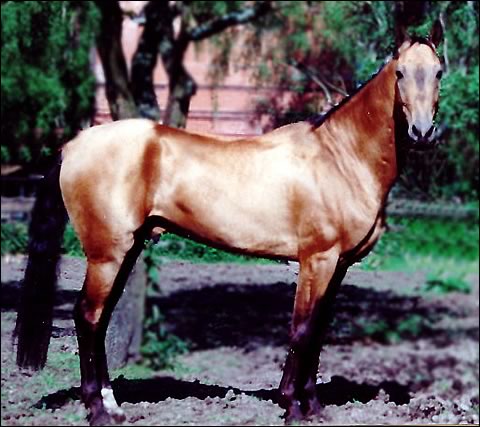The role of war horse breeds is largely unrecognized and their heroics are forgotten. Carrying the warrior fearlessly into the battlefield, leading the cavalry charge, and transporting the troops were some of the duties performed by the war horses.
They supported their soldier through thick and thick, freezing rain, searing heat, and shellfires. They saw their fellow horses perish with exhaustion, deadly wounds, and starvation. They share the burden of enduring hardship and witnessing horror with the soldiers. Bred for being strong, speedy, agile, and alter, the war horse breeds contributions to the war is no less than the humans.
Some of the war horse breeds are discussed here
Top 7 War Horse Breeds
1. Arabian

Arabian horses are the most popular horses in the horse world. This horse breed, rich in history and heritage, is celebrated for its stamina, strength, intelligence, and grace. Many breeds have Arabian genetics in their bloodlines. Their contributions to many historical events are honorable. They were traded for work and war owing to their willingness to work, and their courage to take the warrior into the battlefield.
History
The history of the Arabian breed dates back to 4500 years. Many oldest breeds became endangered or got extinct but the Arabians never fell out of demand.
- Origin: The Arab horses are native to the Arabian Peninsula. This breed was the prized possession of many Bedouin people who used them for raiding and war. Further breed development happened in the desert climate.
- Selective Breeding: Bedouins were people of the desert and they depended on camels and horses for their survival. They needed a horse breed with certain traits to survive in the unforgiving desert. Arabians developed into warhorses by selective breeding.
- Strains of Arabian Horses: Bedouins developed five primary strains of Arabian horses named Keheilan, Abeyan, Seglawi, Hamdani, and Headband. These strains represented body type and unique traits.
War Chronicles
Speed, alertness, endurance, and intelligence are the desired traits of a warhorse. Arabian horses were bred to have all of them.
- Services in War: Arabian horses were used for hunting, carrying warriors, and pulling chariots in war. Arabian breed appeared in many artworks of Ancient Egypt, the Roman Empire, Ancient Greece, and Mesopotamia where an Arabian was seen serving in the war.
- Islamic History: Muslim warriors rode on Arabians in many wars. When they got control of the Iberian Peninsula in 720 AD, most of them were taken to the battlefield by the Arabian horses. Arabian served the Ottoman Empire in many wars.
Breed Profile
The most recognizable feature of the Arabian breed is their dished faces and high carried tails. Other distinctive features are a refined wedge-shaped head, broad forehead, large eyes and nostrils, small muzzle, laid back shoulders, level croup, and standard correct equine conformation.
Size & Color
The Arabian breed stands anywhere between 14.1 to 15.1 hands. The registered color for purebred horses is chestnut, bay, gray, black, and roan. Spotting pattern known as Sabino exists in the purebred Arabians. Some colors that do not exist in the purebred Arabian gene is the dun, cremello, palomino, or buckskin.
2. Akhal-Teke

Akhal-Teke is considered one of the most handsome horses in the world. It’s not just their beauty they are known for, their speed, agility, endurance, soundness, and intelligence also give them recognition. These Turkmenistan war-horses are well ahead of several breeds in beauty and stamina. They held the horse lover’s heart captive when seen glimmering with gold in the sunlight.
History
The historians name many ancestors of Akhal-Teke, the topic is still open to debate. Some consider Nissan horses to be the ancestors whereas some believe they are the descendants of the Turkoman horse.
- Native Land: Indigenous to the Teke Turkoman tribe located near the Akhal oasis, they were named after their place of origin.
- Breed Development: Selective crossing with other breeds by the tribesmen led to a horse that was faster and agile. There was no registry to record the bloodlines back then rather the Turkomen tribesmen kept the record orally. Breeding with thoroughbred and Arabian created a resilient horse.
- Influences on Other Breeds: These horses were given as diplomatic gifts to many Head of States, which led to the spread of the breed across the world. Trakehner, Don, Budyonny, Karabair, and Karabakh.
War Chronicles
The journey of the Akhal-Teke from an ancient warhorse to a now pleasure riding horse was not a smooth sail. From several war tragedies to being endangered, the Golden horse has seen it all. There are many monuments of the Akhal-Teke horses in remembrance of their contributions to the war.
- Russian Military: Akhal-Tekes were primarily used for raiding in Turkmenistan. In the 19th century, the Russian Empire took over Turkmenistan so Akhal-Teke started serving the Russian military. Akhal-Teke became the center of attention during the tribes’ fights with the Tsar. The Russian general Kuropatkin fell in love with the Akhal-Teke, founded a breeding farm in their name.
- Soviet Union: In the 1930s, the Soviet Union required a better saddle horse for the cavalry and Akhal-Teke served that purpose. The Soviet Union did irreversible harm to the breed as they allowed the slaughtering for meat, which reduced the breed population. Around 1250 Akhal-Tekes were left at one point.
- World War I: Breed decimation happened in World War I. The number of Akhal-Teke declined significantly after WWI.
Breed Profile
Akhal-Teke, a horse with a unique metallic gleam, has quite a few distinctive features that stand him out from the crowd. The Akhal-Teke has a small refined head with almond-shaped hooded eyes and long ears.
Long upright neck, sloping shoulders, long muscular back, flat croup, and thin skin are some common traits.
Size & Colors
The average height of Akhal-Teke ranges between 14.2 to 16 hands tall.
Desirable colors for this breed are Golden buckskin and palomino. Other common colors include bay, grey, black, and chestnut.
3. Budyonny

Budyonny or otherwise known as Budenny or Budennovsky is a warhorse breed originating from Russia. The modern Budyonny horses resemble Thoroughbred because of their sturdy build and strong bone structure. Budyonny horses are brave, loyal, agile, spirited, mild-mannered, and energetic. There are three main intra-breed types of Budyonny are
- Massive Type
- Medium Type
- Oriental Style
History
Byddonny is not an old horse breed rather they were developed in the 1920s. They were bred after the Russian Revolution as a military horse.
- Breed Descent: The breed was called after Marshall Semyon Budyonny, a Bolshevik cavalry commander, who was a well-known breeder, credited for the breed development of Budyonny. They were initially bred in the Rostov region of Russia after the fall of Tsar.
- Breed Development: Budonnys were bred by the crossing of local Russian Don and Chernomor mares and Thoroughbred stallions. In the initial round of breeding, the blood of Kirghiz and Kazakh was also used, later Budonnys genetics were used to develop these breeds.
War Chronicles
The all-round Budonnys are versatile and adaptable horses bred to survive the cruelest conditions without human help. To compensate for the loss of horses following the fall of the Tsar, Budonnys were bred.
- Russian Military Services: Budonnys were solely bred for the purpose of military service. The breed was developed further with the intention of creating the best military riding horses.
- World War II: After significant decimation of horse breeds in World War I, Budonnys were developed as cavalry horses for the Russian military. Budonnys became an indispensable part of the Russian Cavalry Division in World War II and after.
Breed Profile
Just like the Akhal-Teke, the coat of Budonnys also has a metallic shine. Some common features are straight profile, sloping shoulders, pronounced withers, deep chest, long back, slightly sloping croup, long legs, and well-formed hooves.
Size & Color
Budonny mares, on average, are 16 hands tall, whereas, Budonny stallions have an average height of 16.1 hands. The common coat color of this breed is chestnut with a golden sheen. Other color includes black, bay, and grey.
4. Waler
Waler is an Australian horse breed, influenced by other breeds in their gene pool like a thoroughbred, Timor pony, Arab, and Cape horse. Evolved into hardy horses with immense strength and endurance, Walers were prized as a military remount. Walers performed cavalry duties and their gait was deemed best for the cavalry mount.
History
Their name is the reflection of their place of origin, New South Wales.
- Life in Colonial Australia: Walers were developed in colonial Australia by crossing with multiple heavy draft breeds. After crossing with strong coach horses, a sturdy breed was developed which can withstand harsh Australian weather conditions and heavy-duty work.
- Overseas Export: In a short amount of time, there was a booming demand of these Australian horses in the military. They were bred and exported overseas in the 1830s. A significant number of Walers were traded to the British Indian Army.
War Chronicles
Walers were the backbone of Australian Light Horse mounted forces and fought many wars heroically. Walers became the talk of the town because of their unmatched abilities to carry out cavalry duties. These cavalry horses impressed everyone with the courage they carried the rider into the battle.
- Boer War: Walers were used by the Australian Infantry Forces, in the Boer war. Australia sent 16,314 horses overseas to fight in the battle.
- World War I: Over the course of World War I, 121,324 Walers were dispatched from Australia to the allied armies of Europe, Palestine, Africa, and India. The First Australian Imperial Force benefited from the services of 39,348 whereas 81,976 served the Indian Army. Due to the high cost of returning horses back, only one Waler named Sandy made it back home to Australia.
- World War II: Again, in World War II, 360 Australian Walers were appointed to serve Texas National Guard 112th Cavalry in New Caledonia.
Breed Profile
This warhorse breed is well known for their intelligence, bravery, and loyalty. Alert eyes, refined head, strong neck, rounded back, deep hindquarters and girth, and fine tail are the common features of Walers.
Size & Color
The average height of Walers stands between 10 to 17 hands, whereas, the height of most Walers lies between 14.2 to 16 hands.
The common colors of Walers are black, bay, brown, chestnut, and gray. Some Walers are also seen in roan, pinto, buckskin, palomino, taffy, and dun colors, though it is rare.
5. Nisean Horse

image source https://alchetron.com/cdn/nisean-horse-193ff69b-d144-42fb-98a6-c761e51ac5d-resize-750.jpeg
The Nisean or Nisaean horses were considered the sacred breed in the Achaemenian Persians. The now extinct breed originated from the Nisaean Plains in the southern region of the Zagros Mountains, Iran. Chinese called these horses Tien Ma meaning Heavenly Horse or Soulon-Vegetarian dragon. The Nisean was considered the most beautiful horse alive and used to pull Shah’s royal chariot. They fought numerous battles along with many great emperors.
History
The origin of the Nisean breed is lost to time as their history goes back to 430 BCE.
- Breed Descent: In the period of Darius’ reign, the third Persian king of the Achaemenid Empire, Nisean breed was bred from Armenia to Sogdiana.
- Breed Development: Greeks also participated in the development of the breed by breeding them to their native stock.
- Royal Horses: Pure white Niseans were kept as royal horses by the kings. Cyrus the Great loved his Nisean Stallion so dearly that when his Nisean got drowned in a river, he had the whole river drained.
War Chronicles
Nisean horses were loved by many royals, they fought many invasions together. These loyal horses stood by their emperor’s side through thick and thin. There are many historical events that witnessed several victories by Nisean.
- Thessaly Invasion: Thessaly got invaded by Xerxes, in 481 BCE. Nisean mares were successful in beating the legendary Thessalian mare when raced against them.
- Sasanian Cavalry Unit: Zhayedan was the elite cavalry unit of the army of the Sasanian Empire. Nisean horses are believed to be part of the cavalry unit.
- Battle of Carrhea: Nisean horses fought the Battle of Carrhea with their royal leader. It was the first time Roman encountered Nisean.
- Battle of Plataea: The battle of Plataea was fought between Persia and Greece. For this battle, Nisean horses were heavily trained.
Extinction of the Nisean breed happened in the year 1204 with the conquest of Constantinople.
Breed Profile
As many writers and emperors have written, Nisean horses were the most beautiful horses alive.
They had a robust head which is considered a characteristic for a great warhorse.
There were spotted and solid horses in the breed. Tall and swift Nisean horses had a very smooth gait.
Size & Color
As Nisean was an ancient breed, the size of them is not certain.
Nisean breed came in several colors in the equine spectrum, some common, some rare. Common color includes chestnut, seal brown, and dark bay while the rarer color involves roan, palomino, and black.
6. Russian Don
The Don horses are known for withstanding the extreme conditions perfectly. Their endurance has been tested several times through long-distance rides and their ability to withstand freezing winters and searing heat. Robust-natured Don horses with a high level of endurance and stamina hold a record of covering 2400m in a time of 2 minutes 43 seconds in flat races.
History
The history of the Don breed goes back to the 16th century but they were not in demand until the early 19th century.
- Origin: Don horses were bred by the Cossacks tribes located near the Don and Volga rivers in the Southern part of Russian. They were called after the river Don.
- Breed Development: The breed was developed from semi-feral Russian steppe horses and the Oriental horse breeds like the Karabakh horse, Turkmenian, and Arabian. To create taller Russian Don horses, the breed was crossed with Thoroughbred and Orlov horses.
War Chronicles
Though little is known about this breed abroad, they were a famous cavalry mount in Russia. They served the military and fought many battles alongside the soldiers.
- Cossacks Cavalry Horses: Initially, Don horses were used in raiding but then they got promoted to the cavalry horse rank.
- Russian Civil War: Don horses fought the Russian Civil War along with the warriors but there was a significant decrease in breed population afterward.
- World War I: They served in WWI, but just like the Russian Civil War, many don horses were killed, only a few hundred of the breed remaining.
Breed Profile
Some physical breed characteristics include a refined head, straight profile, expressive eyes, well-formed neck, high withers, deep chest, sloping croup, long legs, and tough hooves.
Size & Color
The average height of Don horses stands anywhere between 15.2 to 16.2 hands. They weigh around 1700 pounds.
Common coat color includes chestnut, bay, black, and grey.
7. Turkoman

image source https://upload.wikimedia.org/wikipedia/commons/9/99/Achaltekkiner.jpg
The Turkoman horse or Turkmene is a mighty horse of the oriental horse breed, having the characteristics of both race and warhorse. It is believed that the purebred Turkoman horses are now extinct. This all-round horse breed is popular among horse lovers because of their stamina, fast speed, and have fewer health issues. The confirmation of the elegant, tall horse fits that of a warrior horse. These four breeds are considered Turkoman strains
- Akhal-Teke
- Lomud
- Goklan
- Nokhorli
History
The history of Turkoman dates back to the 16th century. They are crossed and developed to become a more refined breed. Their contributions to the gene pool of other breeds are honorable.
- Origin: This Oriental horse breed is indigenous to the steppes of the Turkoman desert.
- Breed Development: Who are the ancestors of the Turkoman horse is a disputed “chicken or egg” question. However, it is believed that the breed evolved through ancient Oriental horsekeeping tradition and breeding philosophy. Historians are certain of the Turkoman breed influences on the Arabian and Thoroughbred.
War Chronicles
Turkoman has its name written in gold when it comes to helping warriors in war. They were used by the tribes of Turkmen for war. The breed was exported to other countries to serve the soldiers.
- Caliph of Baghdad: Turkoman stallions were treasured by the elite palace guards of the Caliph of Baghdad. They were used by the guards for the security of the palace.
- England Soldiers: Colonel Valentine Baker is credited for bringing the Turkoman breed to England. Many English soldiers serving various parts of the East kept Turkoman horses.
- European Military: Turkoman horses were brought to Western Europe by several individuals having connections with the military. Turkoman gave their services to the European military.
Breed Profile:
Though they are recognized for their glistening gold coat, there are some other traits that make them a great warhorse. Well-proportioned head with a straight profile, long, sloping shoulders, long back with sloping quarters, tucked up abdomen, and muscular legs.
Size & Color:
Turkoman, on average, stands between 15 to 16 hands tall.
Traditional coat colors are chestnut, black, bay, and grey. Turkoman horses have several coat colors with a metallic sheen.
Famous War Horses
There were some warhorses whose contributions to the war got them in the spotlight. Some of these horses were
- Sergeant Reckless: Sergeant Reckless fought many battles and was a Korean War hero. In honor of his services on the battlefield, the warhorse was promoted to the rank of Sergeant.(source)
- Marengo: The horse was named after the Battle of Marengo where he served superbly. He was the popular warhorse of Napoleon I of France.
- Bucephalus: Bucephalus was the famous warhorse of Alexander the Great. Bucephalus loved Alexander dearly and only allowed him to ride. Alexander took him to every battle he fought.
- Nelson and Blueskin: Nelson and Blueskin were the two famous war mounts of General George Washington during the American Revolutionary War. Nelson was Washington’s most favorite war mount as he did not lose control around the sound of gunfire and blasts.
Conclusion
No one can deny the support provided by the warhorses to the soldiers on and off the battlefield. Standing fearlessly in the face of the enemy’s fire where the death was almost certain, the war horse breeds have served the warrior with utmost loyalty. Their contributions to the war often go unlauded and their losses are sold short. Nonetheless, their bravery and loyalty to the soldiers are beyond all descriptions. The saying ” History was written on the back of the horses” could not be more true owing to the substantial role of horses in the historical events.
Related Articles







